Some You Win, Some You Lose
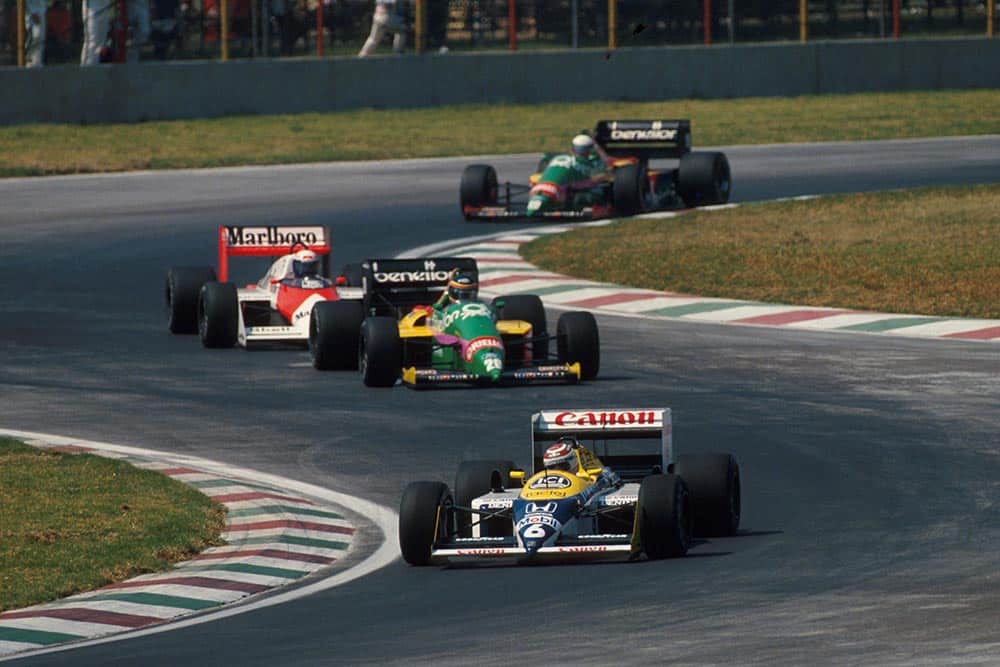
Nelson Piquet in his Williams FW11B, 2nd place in the Mexican GP. Mexican Grand Prix, Mexico City, 18 October 1987
© Motorsport Images
I well recall my personal enthusiasm for Niki Lauda who, apart from being a mate, was a driver I always reckoned had everything all weighed up. In 1977, when he won his second World Championship title for Ferrari, I thought he won it by cunning and good judgement.
DSJ on the other hand, reckoned he did so by stealth and consistency. In other words, “playing the points game”. For the record, Mario Andretti won four races in 1977 to Lauda’s three, although the charismatic Italian/American driver went on to take the title the following summer.
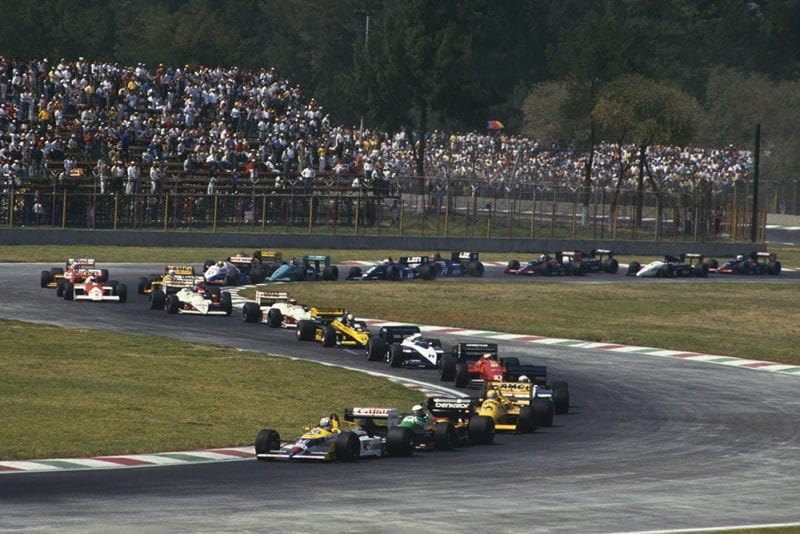
Nigel Mansell (Williams FW11B Honda) 1st position, leads Teo Fabi (Benetton B187 Ford), Ayrton Senna (Lotus 99T Honda) and the rest of the field on the first lap of the Mexican GP.
Ref: 87 MEX 09. World Copyright – LAT Photographic
© Motorsport Images
Now the question this is all leading round to is: “If AH was such an enthusiast for Lauda’s way of doing things, why doesn’t he approve of the way in which Nelson Piquet won the 1987 title?” Or, to put it another way: “If Jenks disapproved of the way in which Lauda won in 1977, why doesn’t he disapprove of Piquet’s title success in 1987?”
I suppose it all comes down to some sort of personal “sixth sense”. Lauda won in 1977 against the backdrop of Mario’s efforts — and if there was ever a universally popular Grand Prix ace, it was Andretti. Piquet won his title in a straight fight against Nigel Mansell, his Williams-Honda team-mate.
Basically, I approved of Lauda as a driver more than I do Piquet, simply because I think Niki was more commited to his racing in ’77 than Nelson has been this year. And Jenks approves of Piquet more than Lauda because he admires the Brazilian’s shrewd, rather calculating, distinctly individual way of doing things. Mansell doesn’t raise the same enthusiasm, from a personal point of view, as did Andretti.

2nd place Ayrton Senna in tha Lotus 99T during the Japanese Grand Prix.
© Motorsport Images
Right, if everybody has got the general drift of my logic, we will examine how the Mexican and Japanese Grands Prix unfolded — the latter event returning to the calendar after an absence of ten years.
The Mexican race once again took place on the superb Autodromo Hermanos Ricardo y Pedro Rodriguez, one of the most spectacular tracks in the world with undoubtedly the worst surface. Mansell was bang on form in his Williams-Honda FW11B, although the manner in which he drives on the “ragged edge”, in totally committed style, was underlined when he spun wildly come onto the start/finish straight and made light contact with the pit wall.
Two weeks later, fighting yet another typically on-the-limit battle for pole-position at Suzuka, the determined Englishman spun into a protective tyre barrier at high speed, and was shaken enough not to be able to take part in the Japanese race.
It was a sad way to end the season for the Englishman. At Mexico, he had used his head to score a clever win in a race which was prematurely stopped after an accident to Derek Warwick (who was thankfully unhurt) and then restarted to produce an aggregate result. Having won the first “heat” after the retirement of pace-setters Thierry Boutsen (Benetton B187) and Gerhard Berger (Ferrari F187), Mansell then played second-fiddle to Piquet in the second “heat”. But not before he had attempted to overtake the Brazilian and recieved “the chop” extremely severely on at least two occasions.
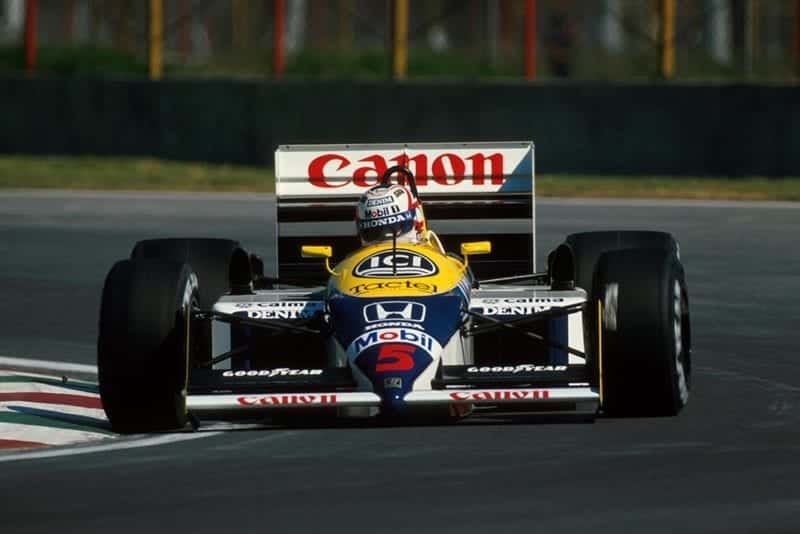
Mexican GP winner Nigel Mansell in his Williams FW11B.
© Motorsport Images
This incident caused the personal venom between the two men to overflow in public. Mansell berated the Brazilian, saying he had tried to drive him off after a season in which he spent most of the time moaning. Piquet countered by saying, in effect: “don’t be so bloody stupid, if I’d wanted to push you off I’d have done so, but I don’t drive like that”.
Then came the Suzuka accident and Piquet’s 12-point lead in the title chase became unassailable when it was clear that Mansell would not be starting the race.
However you look at it, Piquet must have been born under a lucky star. Running slightly slower than his pursuers, having chosen the harder of the two Goodyear tyre-compounds available, he was pushed off on the opening lap at Mexico when Alain Prost locked up the front wheels of his McLaren (a rare mistake) and pitched the Williams into a spin.
Piquet got away unpenalised from a push-start, thanks to the rule which allows a car to be pushed from a place of danger without penalty, and then suffered only his second race engine failure of the year in Japan — where Mansell was not on hand to capitalise on his ill-fortune
The Mexican Grand Prix also saw Ayrton Senna’s last chances of the title go down the drain, his active-suspension Lotus-Honda 99T proving a very tricky proposition on this bumpy track and he survived a high speed qualifying accident at the wheel of the spare car the day before the race.

Alain Prost overtakes in his McLaren MP4/3 in the
Japanese Grand Prix.
© Motorsport Images
It is a tribute to the constructional strength of the current breed of Grand Prix car that, after his designated race car suffered an electrical malfunction in its active suspension computer control system, Senna was able to switch back to the repaired spare car for the start. In the event, he succumbed to clutch failure and, in the heat of the moment, struck a marshal. He was fined $15,000 for this untypical loss of temper.
Of course, much was expected from the Honda teams in Japan where the first Formula One Japanese Grand Prix for ten years was staged at the Suzuka track near Nagoya, which is a wholly Honda-owned facility used extensively for product testing work. Built in 1962, this 3.6-mile circuit attracted almost unanimous praise from the drivers as a challenging, interesting and satisfying venue — nice to hear some unreserved praise in Formula One for a change!
Honda was obviously delighted that “its man” Nelson Piquet clinched the championship on Japanese soil, but the way in which his Williams FW11B trailed into the pits under full view of the television cameras, laying an ominous trail of oil and gunge, was not exactly the way in which it had hoped the story would develop.

Ayrton Senna (BRA) Lotus 99T, crashes during the race. He spun out of the race on lap 55 then the marshals refused to give him a push start.
Mexican Grand Prix, Mexico City, 18 October 1987
© Motorsport Images
In the event, it was Ferrari who won the race, Gerhard Berger underlining the progress made with the F187 throughout the season. The determined Austrian driver led every lap bar one to score a commanding success.
The nice thing about Berger was that he fully realised luck had been running on his side — and said so after the race. He made the point that he did not think Piquet had to press too hard at Suzuka, knowing that Mansell was not there to be beaten anymore, and that when Alain Prost’s McLaren sustained a puncture on the second lap, while sizing up the leading Ferrari from second place, he did not have to worry about the Frenchman either.
In fact, although Prost only finished seventh, his Japanese performance was one of the drives of the year. By the time he had limped back round to the pits and changed the offending left rear tyre, he was two laps down on the leading Ferrari. He resumed to charge back into contention, making up one of those laps on the entire field by the finish and consistently lapping a second faster than any other car on the circuit. It was a truly momentous piece of driving, produced for no other reason than self-respect on the part of the McLaren team leader.
Prost’s team-mate Stefan Johansson, meanwhile, moved in to challenge Berger and, for a few laps, it looked as though the genial Swede might pick up the McLaren team’s fallen standard and perhaps even win the race.
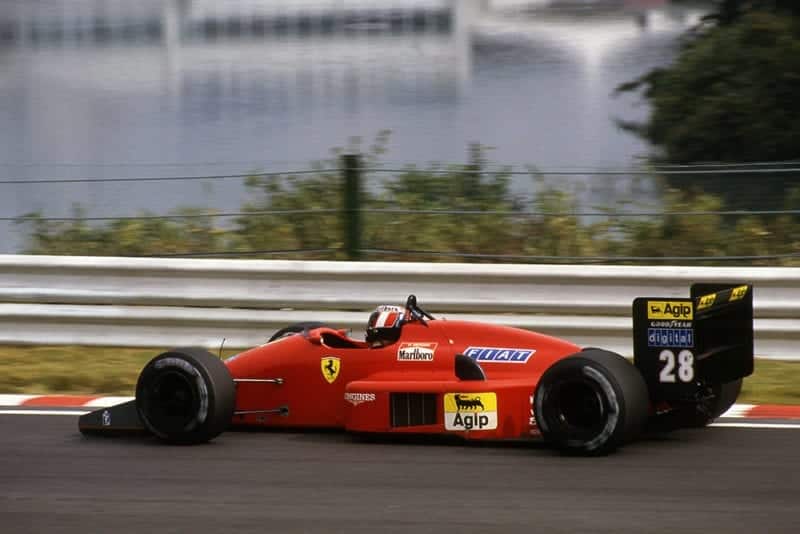
Gerhard Berger heading for a win at Suzuka in his Ferrari F1/87.
© Motorsport Images
However, Stefan had to ease off and keep an eye on his fuel consumption figures and, by the last lap, he was so marginal in this respect that he was unable to fend off Ayrton Senna’s Lotus 99T which nipped through to take second place. That was some consolation, at least, for Honda, which will have the formidable combination of Prost and Senna using its engines in brand new McLarens in 1988.
Michele Alboreto also produced a memorable performance in the second Ferrari at Suzuka. On the starting grid his clutch went solid, so he stalled as the green light came on, causing the field to scatter around him. In the ensuing mayhem Alliot’s Larrousse-Calmels Lola was shoved into the pit wall (and out of the race) by Arnoux’s Ligier. Alboreto was push-started away in last place.
The Italian dearly wanted to put Ferrari back on the winning map once again, and simply flew through the field to fourth place, despite a flat-in-sixth spin when Nannini’s Minardi inadvertently closed the door on him, and a detached and trailing exhaust pipe which progressively took the edge off the Maranello V6’s throttle response.
It was heartening to see Alboreto give Berger a big congratulatory hug at the end of the race, a gesture which concealed his own personal disappointment. “It was more important that the team won again than I did,” he said stoically and without complaint.
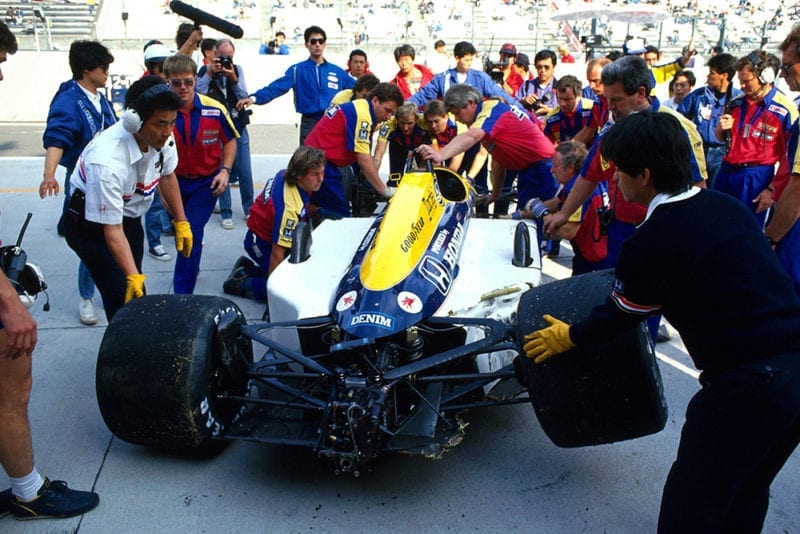
Nigel Mansell suffered a huge crash in practice and had to withdraw from the Japanese Grand Prix.
© Motorsport Images
The Mexican and Japanese races also saw the Benetton-Ford B187 of Thierry Boutsen right up at the front,the cool Belgian taking a turn at leading in the former race — the first time he has run right at the front of a World Championship Grand Prix. He looked as though he had been doing it all his life, driving in his customary confident and unflustered manner, not allowing the excitement of the moment to push him into an error.
Unfortunately an intermittent short-circuit in the Benetton’s wiring-loom caused the engine management computer to burn out in Mexico and, after running a strong second in Japan, he faded to fifth at the finish thanks to poor fuel consumption.
For Japanese enthusiasts, Satoru Nakajima did a good job in front of his compatriots by finishing sixth at Suzuka, re-taking Cheever’s Arrows two laps from the finish as the American driver slowed, out of fuel.
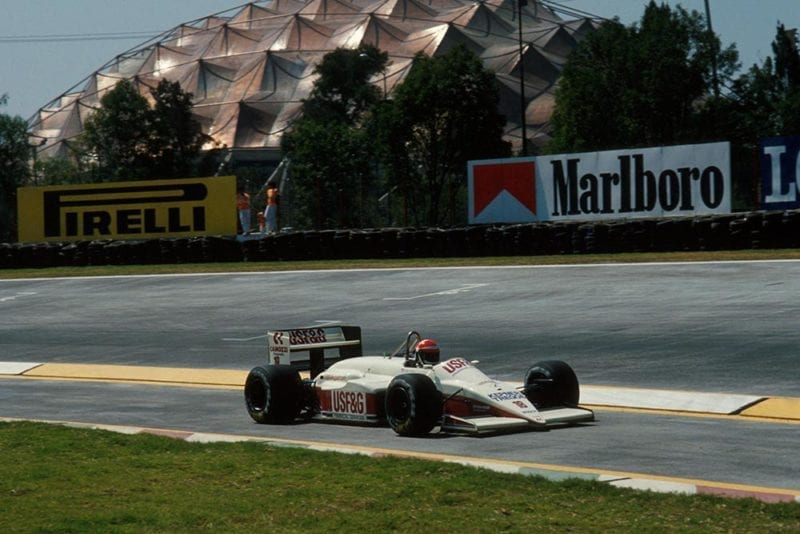
Eddie Cheever finished 4th in his Arrows A10 at the Mexican Grand Prix.
© Motorsport Images
“Nakajap”‘s disciplined outing in Japan was in stark contrast to the second lap fiasco he became involved in during the Mexican Grand Prix, where he apparently forgot to brake at the end of the long start/finish straight as he began his second lap. His Lotus plunged straight into Warwick’s Arrows, wiping off its right front wheel and putting Satoru out of the race.
Derek trailed round to the pits for repairs, but when he later crashed heavily, he put the car’s sudden loss of control down to damage done in that earlier collision. When you watched it from Nakajima’s onboard television camera, you were surprised that Warwick was not out on the spot . . .
So that is how the World Championship struggle ended, leaving the Australian Grand Prix at Adelaide as a meaningless footnote to the title chase.
Mansell had won six races, Piquet three. Yet Nelson has now won three World Championships and Nigel not one. Williams had clinched the Constructors’ title by miles, yet lost its Honda engines to McLaren. And happily, Ferrari is back in the winning business. It’s all go . . . AH
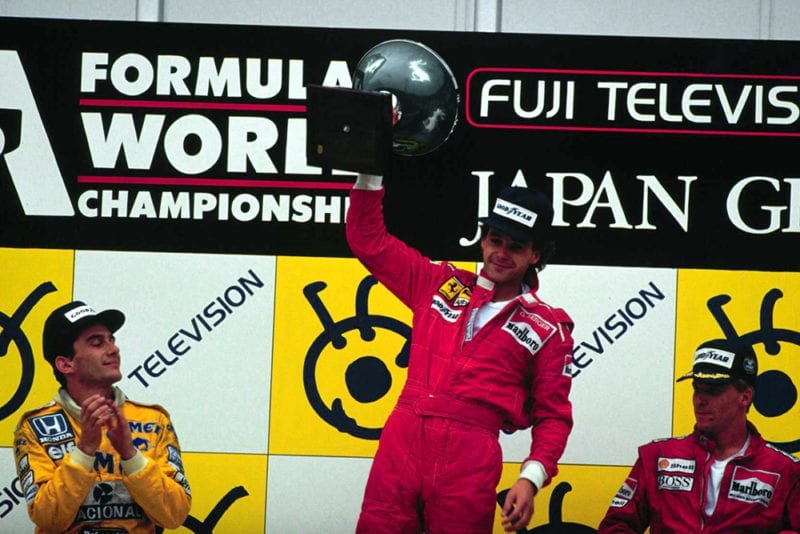
On the podium at Suzuka, Japan, Gerhard Berger, Ayrton Senna and Stefan Johansson celebrate finishing in 1st, 2nd and 3rd positions respectively.
© Motorsport Images
